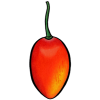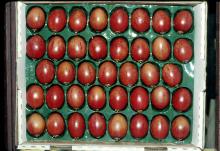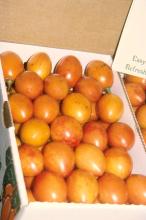Maturity and Quality
Tamarillos reach horticultural (commercial) maturity at 21-24 weeks after anthesis, depending on cultivar and production area. Attainment of full red or yellow color (that is characteristic of the cultivar) is the primary maturity index. A minimum soluble solids content of 10% may also be used.
- Tamarillos must be harvested as close to full-ripeness as possible to assure good flavor for the consumer
- The average content of total sugars (sucrose + glucose + fructose) is 6% and of total acids (mainly citric acid) is 1.8% (fresh weight) in a ripe tamarillo fruit, which explains its acidic (sour) taste
- Size, shape and color uniformity, freedom from defects and decay
Postharvest Handling and Storage
3-4°C (37-39°F)
Storage potential = 6-10 weeks.
10-12ml CO2/kg·hr at 20°C (68°F); non-climacteric respiratory pattern.
To calculate heat production multiply ml CO2/kg·hr by 440 to get Btu/ton/day or by 122 to get kcal/metric ton/day.
Ethylene treatment hastens senescence and stimulates respiration rate but does not improve eating quality of tamarillo fruits.
90-95%
Less than 0.1 µl/kg·hr at 20°C (68°F).
No published information.
Disorders
Chilling Injury. Symptoms include brown discoloration, surface pitting, and increased susceptibility to decay. The minimum safe temperature is 3-4°C (37-39°F), depending on cultivar and storage duration.
- Bitter rot, caused by Glomerella cingulata (Stonem.), is the main postharvest disease of tamarillos
- An effective preharvest integrated pest management program greatly reduces postharvest decay problems
- A hot water dip at 50ºC (122ºF) for 8 minutes effectively controls quiescent infections by Colletotrichum spp





